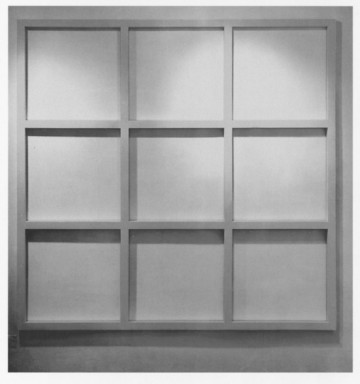
Originally published in the Northside San Francisco in September, 2011
In my case, I used the elements of these simple forms – square, cube, line and color – to produce logical systems. Most of these systems were finite; that is, they were complete using all possible variations. This kept them simple. —Sol LeWitt
The San Francisco Museum of Modern Art has acquired a sculpture by minimalist artist Sol LeWitt, one of the most influential artists of his generation. Wall Grid is a sculpture featuring LeWitt’s trademark neutral colors and spare geometric stylings.
Some might look at Wall Grid and wonder “Why is this art?” Let’s explore that topic.
For years I went with my sister and young nephews to the Chicago Art Institute. Children in museums ask all the right questions. “Why is Pollock a good painter? It doesn’t look like anything but paint to me” I usually gave them some variation of this response. We can do two things, I’d say; we can find something else that you enjoy looking at, or we can investigate your question about this art that you think you don’t like or understand. Usually they opted for the investigation, and when they deconstructed their reaction to the art, they often came to realizations that were very close to the artist’s original intention.
Sol LeWitt was a seminal figure in the history of the Minimalist and Conceptual art movements of the 1960’s and 1970’s. During his lifetime, LeWitt created thousands of works of art. Shapes, squares, pyramids, lines and forms: hundreds were drawn on gallery walls, turned into objects directly merged with those walls or morphed into free standing sculptures. Seen together, his body of work appears like a living organism of 2 and 3-D form moving on surfaces, emerging from walls and poised in three dimensions. After earning a BFA in art, LeWitt was a graphic designer, a receptionist at the Museum of Modern Art in New York City, and later an art professor.
Minimalism is a paring down of form to its bare essentials. Traditional narrative and meaning are abandoned. Optical illusions, empty space, shadows and light are employed as a part of the work instead of merely the environment surrounding the work. The identity of the art object becomes mysterious by virtue of its simplicity.
A work of art is like a word. Considered on its own, it has little context. Taken with other words, it forms a sentence. Meaning is revealed. It’s the same with art. Wall Grid, with no other knowledge of
LeWitt or his time, makes little sense to the viewer but after hearing a few sentences the language can be learned. Combined with the works of other artists of his era, Sol LeWitt’s art becomes part of a larger conversation which is art history.
So take a look. Visit MOMA’s newest acquisition and see where your mind leads you. There’s a multitude of wonderful art for the viewing, but be cautious. Don’t completely disregard a work of modern art. You might be turning your back on an adventure.